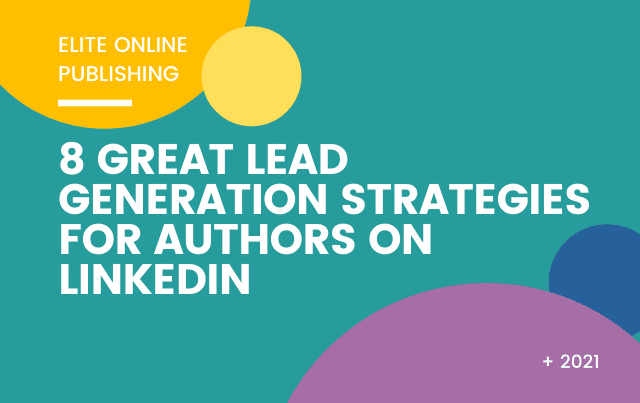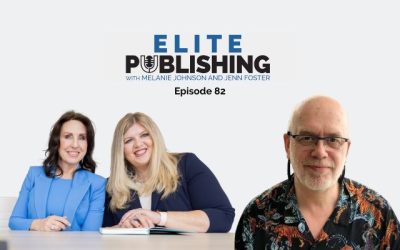8 Great Lead Generation Strategies for Authors on LinkedIn
1. Optimize your LinkedIn profile
Think of your profile as your landing page on LinkedIn. Like any other landing page, it should be designed to get people to DO something:
- Sign up for your newsletter.
- Schedule a free call with you.
- Take your digital Training course.
- Follow you on other social media.
- Order your book in a free-plus-shipping offer.
To increase your credibility, start by weaving your book into your profile:
-
-
- Add it to your profile intro section (Author of My Great Book Title)
- Include it in your profile banner image.
- List it as a publication.
-
If your book is aligned with the same target audience as your ultimate marketing goal, including it in your profile will increase your reputation and prestige immediately—even with people who have never met you. Why? Because you’re now an expert in your field you wrote your book about. You literally wrote the book on it.
2. Create posts around your book content
Create posts (a.k.a. status updates) around your book content. These can be almost anything:
- Graphics made of quotes taken from your book
- Bite-sized insights from your book
- Actionable advice from your book
- Charts or tables that appear in your book
Your posts should always provide value. They should include helpful ideas, advice, or information that people will find useful. Ideally, they’ll find it valuable enough to share with their own audience.
3. Create articles around your book content
On LinkedIn, posts and articles aren’t the same thing.
- Posts are short, quick status updates. They’re usually just simple text.
- Articles are longer-form pieces that establish you as an Author.
When you write LinkedIn articles around your book content, try to tie them to something that’s timely or popular, preferably both:
- Current events getting a lot of press
- Movies or shows that are trending
- Topics or hashtags currently popular on social media
- The time of year (holidays, tax time, back-to-school, etc.)
By repurposing popular content into LinkedIn posts and articles, you’ll generate dozens if not hundreds of shares, follows, and connection requests, significantly increasing your visibility, brand awareness, and credibility.
As a final touch, create a solid byline and include it at the end of your articles. If you’ve titled your book well and you’ve created a solid marketing funnel around it, this can be as simple as:
- Jane Doe, Author of My Great Book Title. Visit my profile to … X.
What’s X? Anything that fits your marketing strategy.
- … see my top sales tip of the week
- … download my free book on building a 7-figure business
- … watch my free webinar on fin-tech trends
Remember, start by optimizing your LinkedIn profile to get people to take a specific action. Then, drive them to your profile with a great byline at the bottom of your engaging LinkedIn articles.
4. Create videos around your book content
You can use videos on LinkedIn the same way you would use articles:
- Create great videos.
- Share them on LinkedIn.
- Watch people flock to your profile.
Like your articles, your videos need a “byline” of sorts. But in this case, you’ll want to put that byline upfront. Every video should start with a casual introduction that tells people who you are.
Keep it short, so people who watch a lot of your videos don’t get sick of it. At the same time, put enough of a hook in it so new people will notice it and remember you.
Again, this can be as simple as your name, your book title, and how you help people:
- “For those of you seeing me for the first time, I’m Jane Doe, Author of My Great Book Title. I help people turn simple ideas into 8-figure franchises.”
Then, at the end of the video, include the “next-step” piece:
- “If you’d like more information, visit my profile to …”
Remember, this part should be an offer. Always follow value with more value. When people visit your profile, they should get something else that can help them, further building your connection.
5. Offer to help others
If you’re more comfortable talking with people one-on-one than writing articles or making videos, consider offering slots of your time instead. Use these time slots to help people in a specific way, such as:
- Offering to review resumes or portfolios for new people in your field.
- Offering to donate your expertise to nonprofits.
- Offering short, specific sessions for just about anything (“here’s exactly what I’ll do for the first 10 people to sign up”).
What kind of sessions should you offer? Again, these can be anything that will promote shares within the audience you want to reach:
- To help small businesses move into digital marketing, I’m offering free 30-minute consultations to the first 10 people who sign up.
- To help small service companies that had to shut down during COVID-19 …
- To help salespeople learn how to generate B2B leads …
The ideal offer will move people closer to your ultimate goal. For example, if you want Amazon store owners to hire you as a consultant, offer free 30-minute marketing consultations to Amazon store owners.
If you keep it short, specific, and targeted, these kinds of offers can go viral as people share them within their own networks.
ELITE PRO TIP: Calendly is a great tool for letting people sign up for specific time slots on your calendar.
6. Ask for relevant stories/case studies
If you’re looking for article ideas or real-world stories that are relevant to your book, you can market your own marketing efforts by posting questions on LinkedIn and asking your network to help.
- “I’m building a website to help people avoid email scams. Have you ever fallen for an email scam? Or do you know anyone who has? I’d love to include it in my warning list!”
- “In my book, I tell the story of how I … Have you ever done this? How did it work out for you?”
- “The best advice I ever got was … I’m building a website to go with my new book on that. What’s the best advice you ever got? How has it made a difference in your life?”
Obviously, this kind of outreach has to align with the right goal, but it can work well in forging new connections and gathering content for podcast interviews, articles, speaking gigs, etc.
Just be specific in what you’re looking for and in telling people how to follow up with you (such as via inmail or by visiting a landing page).
7. Connect with relevant LinkedIn Groups
Another great way to use LinkedIn to expand your professional network is to find and join LinkedIn groups that are relevant to your target audience.
Want to coach B2B marketers? Join a B2B marketing group. Want to help people monetize blogs? Join a group on blogging. There are groups for just about anything you can imagine, from specific job titles to decision-makers at every level.
Just be careful about prospecting in groups—most LinkedIn groups ban anything that sounds like a sales pitch. Instead, offer their group members value in the form of free, high-quality content and let them come to you.
LinkedIn posts should be designed specifically for each group, offering relevant content. For example, if you offer SEO services, you could:
- Offer free advice on SEO metrics in a content marketing group.
- Offer free advice on vetting SEO providers in a small business leadership group.
You’ll be welcomed by LinkedIn users everywhere as long as you’re providing relevant, valuable messaging and content.
8. Run paid ads
Like all social media platforms, LinkedIn marketing lets you run paid ads that target potential customers to generate new leads.
Unfortunately, LinkedIn lead generation is relatively expensive, with a much higher cost per potential lead when compared to other social networks like Facebook.
Still, LinkedIn is the best place for B2B outreach and advertising, especially if you’re trying to use social media marketing to sell high-dollar B2B services.
If you stand to make a lot of money from even one customer, it’s worth the higher cost of attracting LinkedIn accounts to your marketing funnel—especially if you’re marketing to companies or business professionals.





0 Comments